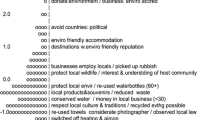Abstract
Despite the importance of Christmas within many cultures, researchhas not examined the types of experiences and activities that are associated withholiday well-being. Thus, we asked 117 individuals, ranging in age from 18 to 80,to answer questions about their satisfaction, stress, and emotional state during theChristmas season, as well as questions about their experiences, use of money, andconsumption behaviors. More happiness was reported when family and religiousexperiences were especially salient, and lower well-being occurred when spendingmoney and receiving gifts predominated. Engaging in environmentally consciousconsumption practices also predicted a happier holiday, as did being older and male.In sum, the materialistic aspects of modern Christmas celebrations may underminewell-being, while family and spiritual activities may help people to feel more satisfied.
Similar content being viewed by others
REFERENCES
Argyle, M.: 1999, ‘Causes and correlates of happiness’, in D. Kahneman, E. Diener and N. Schwarz (eds.), Well-being: The Foundations of Hedonic Psychology (Russell Sage Foundation, New York), pp. 353–373.
Baron, R.M. and D.A. Kenny: 1986, ‘The moderator–mediator variable distinction in social psychological research: Conceptual, strategic, and statistical considerations’, Journal of Personality and Social Psychology 51, pp. 1173–1182.
Baumeister, R.F. and M.R. Leary: 1995, ‘The need to belong: Desire for interpersonal attachments as a fundamental human motivation’, Psychological Bulletin 117, pp. 497–529.
Belk, R.: 1989, ‘Materialism and the modern U.S. Christmas’, in E.C. Hirschman (ed.), Interpretive Consumer Research (Association for Consumer Research, Provo, UT), pp. 115–135.
Belk, R.: 1993, ‘Materialism and the making of the modern American Christmas’, in D. Miller (ed.), Unwrapping Christmas (Clarendon Press, Oxford), pp. 75–104.
Caplow, T.: 1982, ‘Christmas gifts and kin networks’, American Sociological Review 47, pp. 383–392.
Caplow, T.: 1984, ‘Rule enforcement without visible means: Christmas gift giving in Middletown’, American Journal of Sociology 89, pp. 1306–1323.
Carrier, J.: 1993, ‘The rituals of Christmas giving’, in D. Miller (ed.), Unwrapping Christmas (Clarendon Press, Oxford), pp. 55–74.
Center for a New American Dream: Simplify the Holidays.
Costa, P., A. Terracciano and R.R. McCrae: 2001, ‘Gender differences in personality traits across cultures: Robust and surprising findings’, Journal of Personality & Social Psychology 81, pp. 322–331.
Eigner, S.: 2001, ‘The relationship between “protecting the environment” as a dominant life goal and subjective well-being’, in P. Schmuck and K.M. Sheldon (eds.), Life Goals and Well-being: Towards a Positive Psychology of Human Striving (Hogrefe & Huber Publishers, Gottingen), pp. 182–201.
Emmons, R.A., C. Cheung and K. Tehrani: 1998, ‘Assessing spirituality through personal goals: Implications for research on religion and subjective well-being’, Social Indicators Research 45, pp. 391–422.
Fischer, E. and S.J. Arnold: 1990, ‘More than a labor of love: Gender roles and Christmas gift shopping’, Journal of Consumer Research 17, pp. 333–345.
Gallup Organization: 2000, Do you celebrate Christmas? Question ID: USGALLUP.00DB02, R30. Accessed April 2, 2002 from Lexis-Nexis/Polls & Surveys.
Hirschman, E.C. and P.A. LaBarbera: 1989, ‘The meaning of Christmas’, in E.C. Hirschman (ed.), Interpretive Consumer Research (Association for Consumer Research, Provo, UT), pp. 136–147.
Jessen, G. and B.F. Jensen: 1999, ‘Postponed suicide death? Suicides around birthdays and major public holidays’, Suicide & Life-Threatening Behavior 29, pp. 272–283.
Kasser, T.: 2000, ‘Two versions of the American dream: Which goals and values make for a high quality of life?’ in E. Diener and D.R. Rahtz (eds.), Advances in Quality of Life Theory and Research,Vol. 1 (Kluwer, Dordrecht, The Netherlands), pp. 3–12.
Kasser, T.: 2002, The High Price of Materialism (MIT Press, Cambridge).
Kasser, T. and R.M. Ryan: 1993, ‘A dark side of the American dream: Correlates of financial success as a central life aspiration’, Journal of Personality and Social Psychology 65, pp. 410–422.
Kasser, T. and R.M. Ryan: 1996, ‘Further examining the American dream: Differential correlates of intrinsic and extrinsic goals’, Personality and Social Psychology Bulletin 22, pp. 280–287.
Lilienfield, R.M.: 2002, ‘Use Less Stuff. Retrieved April 15, 2002 from http://www.use-less-stuff.com.
Miller, D., (ed.): 1993, Unwrapping Christmas (Clarendon Press, Oxford).
Myers, D.G.: 2000, ‘The funds, friends, and faith of happy people’, American Psychologist 55, pp. 56–67.
Pavot, W. and E. Diener: 1993, ‘Review of the Satisfaction with Life Scale’, Psychological Assessment 5, pp. 164–172.
Sheldon, K.M. and A.J. Elliot: 1999, ‘Goal striving, need satisfaction, and longitudinal well-being: The Self-Concordance Model’, Journal of Personality and Social Psychology 76, pp. 546–557.
Sheldon, K.M., A.J. Elliot, Y. Kim and T. Kasser: 2001, ‘What is satisfying about satisfying events? Testing 10 candidate psychological needs’, Journal of Personality and Social Psychology 80, pp. 325–339.
Sheldon, K.M. and T. Kasser: 2001, ‘Getting older, getting better? Personal strivings and psychological maturity across the life span’, Developmental Psychology 37, pp. 491–501.
Sheldon, K.M. and H. McGregor: 2000, ‘Extrinsic value orientation and the tragedy of the commons’, Journal of Personality 68, pp. 383–411.
Sohr, S.: 2001, ‘Eco-activism and well-being: Between flow and burnout’, in P. Schmuck and K.M. Sheldon (eds.), Life Goals and Well-being: Towards a Positive Psychology of Human Striving (Hogrefe&Huber Publishers, Gottingen), pp. 202–215.
Velamoor, V.R., Z.Z. Cernovsky and L.P. Voruganti: 1999, ‘Psychiatric emergency rates during the Christmas season in the years 1991 to 1997’, Psychological Reports 85, pp. 403–404.
Watson, D., A. Tellegen and L. Clark: 1988, ‘Development and validation of brief measures of positive and negative affect: The PANAS scales’, Journal of Personality and Social Psychology 54, pp. 1063–1070.
Author information
Authors and Affiliations
Corresponding author
Rights and permissions
About this article
Cite this article
Kasser, T., Sheldon, K.M. What Makes for a Merry Christmas?. Journal of Happiness Studies 3, 313–329 (2002). https://doi.org/10.1023/A:1021516410457
Issue Date:
DOI: https://doi.org/10.1023/A:1021516410457




